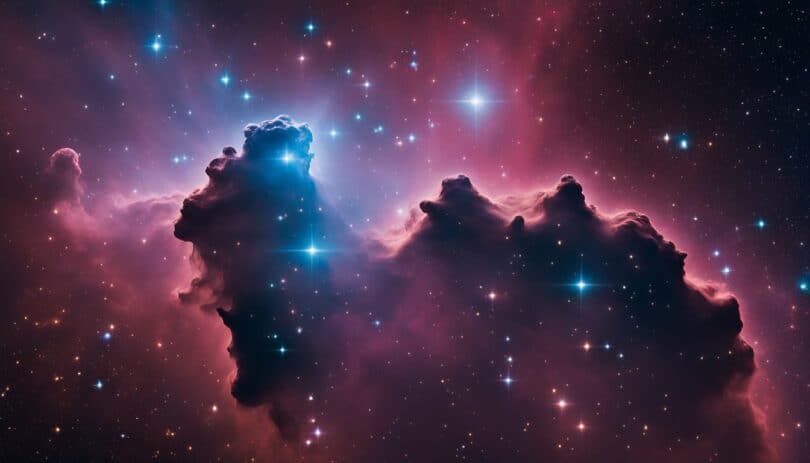We often gaze upon the night sky with wonder, contemplating the origins of the twinkling stars above us.
These celestial beacons are not only sources of light and beauty but also markers of the fascinating process of star formation, a cycle that begins within the cold and vast expanses of interstellar clouds known as nebulae.
Nebulae serve as stellar nurseries, the birthplaces where stars begin their long lives.
In these dense regions of gas and dust, gravity pulls material together to form clumps, initiating the birth of new stars.
As these clumps accumulate mass, their core temperature rises, eventually triggering nuclear fusion—the powerful process that makes stars shine.
Observations by the Hubble Space Telescope have allowed us to witness the dramatic events that shape these nurseries, such as intense ultraviolet radiation and shock fronts that carve out cavities and erode material in the nebulae.
Understanding the life cycle of stars is crucial, not just for our knowledge of the cosmos, but also for comprehending the distribution of elements that are essential for life.
Nebulae do not only cradle stars; they also witness their end. Whether through gradual dispersal or violent supernova explosions, dying stars return their enriched materials to the interstellar medium, contributing to the formation of future stars and planets.
This cycle of stellar birth and death within nebulae is a testament to the dynamic and ever-evolving nature of our universe.
Nebulae: The Cradle of Stars
Before diving into the intricacies of star formation, it’s crucial to understand that nebulae play a defining role. These vast clouds are not only the birthplace of stars, but also the canvas where the art of the cosmos is painted with gas, dust, and the gravitational force.
Star-Forming Nebulae
When we look at star-forming nebulae, we are essentially seeing stellar nurseries. These are regions in space where the conditions are just right for star formation to take place. The Eagle Nebula and Orion Nebula serve as some of the most well-known examples of such environments. Within these nebulae, pockets of hydrogen gas and dust collapse under their own gravity, initiating the process of forming new stars.
- Eagle Nebula (M16):
- Rich in ionized hydrogen gas
- Known for the Pillars of Creation
- Orion Nebula (M42):
- Closest large star-forming region to Earth
- Abundant in protostars and young stellar objects
Role of Gas and Dust
The composition of nebulae is mostly gas—primarily hydrogen—and a smaller component of dust. This mixture acts as the raw material for new solar masses. Gravity pulls the densest parts of the nebula together, forming clumps called molecular clouds. As the cloud’s density increases, the gravitational pull grows stronger, igniting thermonuclear fusion at the core of what will become a new star. This dance between the elements results in the beautiful tapestry of light and color observed in nebulae.
- Molecular Clouds:
- Where gravity causes collapse
- Potential birthplace of stars
Understanding nebulae as the nurseries of space helps us appreciate the immense scales and forces at work in our universe. Through observing these celestial phenomena, we continuously refine our comprehension of the life cycle of stars.
Stages of Star Birth
In the vast theaters of the cosmos, we witness stars coming into existence through a series of intricate steps within the stellar nurseries known as nebulae. Our focus will delve into the pivotal stages from the formation of protostars to the energetic influence of supernovae.
From Protostars to Main Sequence Stars
We begin with a protostar, the early stage of a star’s life cycle. Formed from the gravitational collapse of gas and dust within a nebula, this embryonic star is the premise for what will eventually become a main sequence star. Gravity pulls in material, causing the center to heat up. When it reaches a critical temperature and pressure, nuclear fusion ignites, marking the birth of a newborn star, now part of the main sequence. This is a stellar state defined by the stable fusion of hydrogen atoms into helium, releasing tremendous amounts of radiation and energy.
The Impact of Supernovae
As stars evolve, massive ones conclude their lifespans dramatically with a supernova, a colossal explosion that can briefly outshine entire galaxies. This cataclysm marks the end of the main sequence for these stars. Supernovae are significant; they not only signal the death of stars but also bring about creation, dispersing essential elements across the cosmos, elements necessary for the birth of new stars. Moreover, the forceful outflows from these explosions push against the surrounding gas, potentially triggering the formation of new protostars, thus influencing the next generation of stellar evolution.
Astronomical Observations
In the field of astrophysics, our understanding of star formation is deeply intertwined with the way we observe the universe. Through sophisticated tools and methods, we gather data about nebulae, which are critical to the processes that lead to the birth of stars.
Space Telescopes and Nebulae Exploration
Our utilization of space-based observatories has dramatically enhanced our ability to study nebulae. The Hubble Space Telescope, managed by NASA and ESA, has been instrumental in capturing detailed images of these stellar nurseries. The telescope’s ability to see in the ultraviolet and visible parts of the spectrum allows us to observe the intricate structures within nebulae, shedding light on the environments where stars are formed.
Continuing this legacy, the James Webb Space Telescope (JWST), with its advanced infrared capabilities, is poised to provide even deeper insights. Infrared light penetrates the dust that usually obscures our view, enabling us to look further into the heart of star-formation regions. This telescope represents a collaboration among NASA, ESA, and the Canadian Space Agency (CSA), operated with support from the Space Telescope Science Institute (STScI).
Previously, the Spitzer Space Telescope, also observing in infrared, paved the way for JWST by offering us a glimpse at the cooler and dustier regions where new stars are emerging out of their gaseous cocoons.
Spectroscopy: Decoding Light from Nebulae
Spectroscopy is a powerful technique we employ to unravel the composition and physical properties of celestial objects. By analyzing the light spectrums obtained from nebulae, we decode a wealth of information – from the elements present to the velocities and temperatures of star-forming materials.
Armed with spectroscopic data, our scientists dissect the myriad of lines and bands to understand the dynamics at play within a nebula. This information is pivotal in confirming theories about the life cycle of stars and the complex interplay of forces that govern their birth.
The Cosmos Beyond: Nebulae and Galactic Evolution
In the vastness of the cosmos, nebulae are not just spectacular showcases of cosmic beauty; they are fundamental to the birth of stars and the evolution of galaxies. By understanding these stellar nurseries, we gain insights into the complex processes that shape our universe.
Interstellar Medium and Planetary Systems
The interstellar medium (ISM), the matter that fills the space between stars within galaxies, is a composite of gas, dust, and cosmic rays. It’s within this mix that new stars begin to take shape. Nebulae are significant components of the ISM, serving as the sites where stars and subsequently planetary systems form. In the Milky Way, various forms of nebulae—ranging from the remnants of supernovae to dense molecular clouds—are observed. They create an environment conducive to the birth of stars by providing the necessary material.
Within nebulae, regions of higher density begin to collapse under their own gravity, initiating nuclear fusion. This marks the birth of a star and, potentially, the creation of planetary systems as excess materials orbit the new star, coalescing into planets, asteroids, and comets. The Rho Ophiuchi cloud complex, for instance, provides us with an excellent example of star formation in progress, highlighting the birth of Sun-like stars.
Understanding Nebulae in Different Galaxies
Our pursuit to understand nebulae in different galaxies greatly benefits from observations made by telescopes such as Hubble. The diverse types and roles of nebulae in galaxies such as Andromeda reveal the universality and variability of star-forming processes. Galactic evolution is driven by such processes, with star formation rates, the distribution of elements, and the presence of different types of nebulae painting a picture of a galaxy’s developmental stage.
By studying nebulae, we uncover patterns in the life cycles of galaxies. We see how events like supernovae disperse elements across the interstellar medium, enriching future generations of stars and planetary systems. It’s a cycle of creation and destruction, leading to the continuous transformation of galaxies over billions of years. The Pillars of Creation, a feature within the Eagle Nebula, graphically illustrates this cycle, showing towering structures of gas and dust being eroded by the powerful ultraviolet light from nearby stars.


